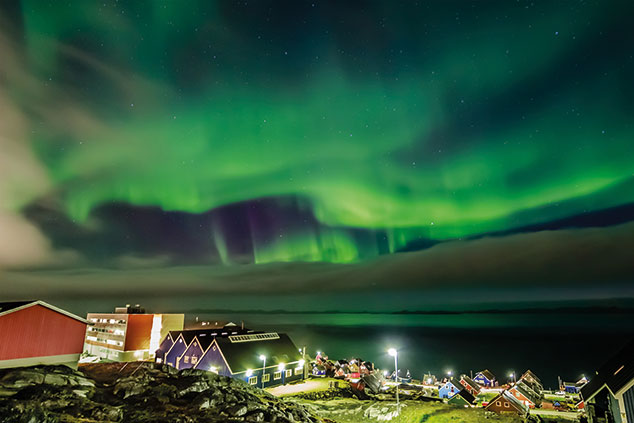
Why the sudden interest in Greenland?
Donald Trump’s offer to buy the self-governing Danish crown territory for the US from Denmark (and his impetuous decision to cancel a state visit to Denmark, a close US ally, when its prime minister pooh-poohed the idea) has put the sparsely populated island, and its future prospects, firmly on the international agenda. President Trump might claim to be sceptical about climate change, once describing it as a “hoax”. But he has clearly noted what the warmer climate is doing in Greenland, where 80% of the island remains covered by ice sheet, but where the average temperature has already risen 1.5˚C since the 1950s (and by 2˚C in some parts of the island). The map of Greenland’s coastline is rapidly changing as the ice melts and new islands emerge. And to the north Arctic sea ice is also receding, allowing for a longer shipping season.
Why is that alluring?
It’s partly to do with the country’s geostrategic position: Greenland was a vital site for US airbases during the second world war and the cold war era, and its importance will grow as new shipping routes open up in the high north. But it’s mostly to do with the rich bounty of natural resources, including iron ore, lead, zinc, diamonds, gold, uranium, oil, natural gas and – perhaps most significantly – the rare-earth elements crucial to the manufacture of much cutting-edge technology. The US considers itself dangerously dependent on China for the supply of rare earths. But Greenland’s reserves of them are estimated at nearly 40 million tonnes, a quarter of the world’s total of 160 million tonnes (the main ones found in Greenland are terbium, praseodymium, lanthanum, neodymium and dysprosium). Until global warming began to melt Greenland’s thick ice sheets, commercial extraction of them appeared unviable. That’s changed – especially since Greenland scrapped its self-imposed ban on uranium extraction in 2013. Greenland is a relatively poor place, where 90% of the economy depends on fishing. In a few decades, the picture might be very different.
So Trump’s offer makes sense?
It makes sense if you’re a billionaire real-estate mogul, used to viewing the world in baldly transactional terms. Such a purchase would not only secure vital US strategic interests, and benefit both the US and Greenlanders economically, but it would also be fully “in keeping with American – and Danish – diplomatic traditions”, argues Republican senator Tom Cotton in The New York Times. The negotiated acquisition of sovereignty is, after all, a “longstanding and perfectly legitimate tool of statecraft”, especially in the American context. More than a third of the territory of the modern-day US was purchased from Spain (the Florida Treaty of 1819); France (the Louisiana Purchase of 1803); Mexico (the Gadsden Purchase of 1854); and Russia (the purchase of Alaska in 1867).
Why in keeping with Danish tradition?
Because Washington and Copenhagen have done this kind of deal before. In 1917, President Woodrow Wilson paid $25m to purchase the Danish West Indies, a colony Denmark had first tried to offload in the 1850s (after slavery was abolished and the sugar plantations had rapidly became unprofitable). Following Wilson’s purchase (via a treaty in which the US also recognised Danish sovereignty over Greenland) the islands were renamed the US Virgin Islands, and they remain a US territory today. By contrast, Denmark has twice previously rebuffed US offers for Greenland. Secretary of State William Seward first tried to acquire it for the US in the 1860s, around the same time that he negotiated the purchase of Alaska. And in 1946, the Harry Truman administration offered Denmark $100m for Greenland, arguing that the island was “indispensable to the safety” of the US in fighting the Soviets, just as it had been during the battle against the Nazis for control of the Atlantic.
So could it happen now?
No. Much has changed since the 19th century, when colonial powers felt free to buy and sell territories without the permission of the people actually living there. Through the 20th century, the doctrine of self-determination has become an integral part of international law and custom, gaining particular strength in the context of decolonisation in the 1950s and 1960s. When the US bought Alaska from Russia in 1867, the 50,000 or so indigenous people living there were not given a say. But the idea that Greenland (home to around 56,000 mostly Inuit people) could be “sold” today is fanciful, unless it were first to become fully independent (perfectly possible) and then negotiate to sell itself directly to the US (all but unimaginable). As the Danish PM put it succinctly: “Greenland is not for sale. Greenland is not Danish. Greenland belongs to Greenland.”
So what can the US do?
What it’s been doing for decades: projecting its power across the globe via strategic, military and commercial partnerships, without going to the bother of actually annexing, or buying, territory. For example, the US recently signed a memorandum of understanding with Greenland to co-operate on rare earth mining to promote investment in the sector. And there is no need to buy the whole of Greenland when the US already has its Thule Air Base there. First built in 1943, these days it hosts US space-surveillance, space-control and ballistic-missile early-warning-system radar. As the Arctic opens up, it might well make sense for the US to expand the Thule base significantly, says Jim Townsend in Foreign Policy. To convince the Danish and Greenlandic governments, the US could offer to offset some of the annual $670m Danish subsidy to the Greenland government, perhaps via US Air Force support contracts with Greenland’s companies. Alternatively, of course, the US president could just needlessly insult the Danish prime minister and spook Greenlanders with his offer to buy them up.